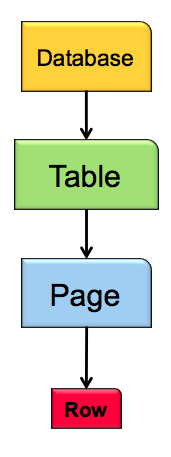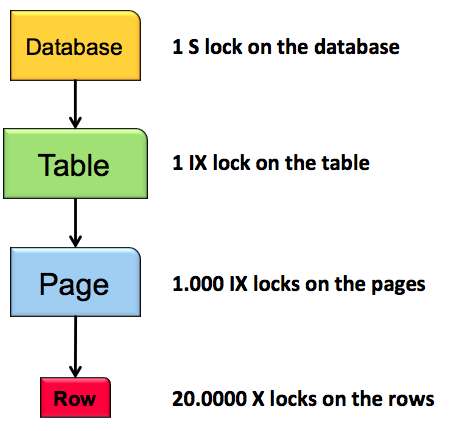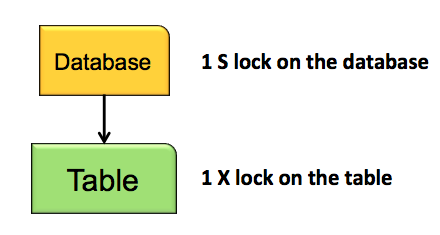In todays blog posting I want to talk about Lock Escalations in SQL Server. Lock Escalations are an optimization technique used by SQL Server to control the amount of locks that are held within the Lock Manager of SQL Server. Let’s start in the first step with the description of the so-called Lock Hierarchy in SQL Server, because that’s the reason why the concept of the Lock Escalations exists in a relational database like SQL Server.
Lock Hierarchy
The following picture shows you the lock hierarchy used by SQL Server:

As you can see from the picture, the lock hierarchy starts at the database level, and goes down to the row level. You always have a Shared Lock (S) on the database level itself. When your query is connected to a database (e.g. USE MyDatabase), the Shared Lock prevents the dropping of the database, or that backups are restored over that database. And underneath the database level, you have locks on the table, on the pages, and the records when you are performing an operation.
When you are executing a SELECT statement, you have an Intent Shared Lock (IS) on the table and page level, and a Shared Lock (S) on the record itself. When you are performing a data modification statement (INSERT, UPDATE, DELETE), you have an Intent Exclusive or Update Lock (IX or IU) on the table and page level, and a Exclusive or Update Lock (X or U) on the changed records. SQL Server always acquires locks from top to bottom to prevent so-called Race Conditions, when multiple threads trying to acquire locks concurrently within the locking hierarchy. Imagine now how the lock hierarchy would look like, when you perform a DELETE operation on a table against 20.000 rows. Let’s assume that a row is 400 bytes long, means that 20 records fit onto one page of 8kb:

You have one S Lock on the database, 1 IX Lock on the table, 1.000 IX locks on the pages (20.000 records are spread across 1.000 pages), and you have finally 20.000 X locks on the records itself. In sum you have acquired 21.002 locks for the DELETE operation. Every lock needs in SQL Server 96 bytes of memory, so we look at 1.9 MB of locks just for 1 simple query. This will not scale indefinitely when you run multiple queries in parallel. For that reason SQL Server implements now the so-called Lock Escalation.
Lock Escalations
As soon as you have more than 5.000 locks on one level in your locking hierarchy, SQL Server escalates these many fine-granularity locks into a simple coarse-granularity lock. By default SQL Server always escalates to the table level. This mean that your locking hierarchy from the previous example looks like the following after the Lock Escalation has been successfully performed.

As you can see, you have only one big lock on the table itself. In the case of the DELETE operation, you have one Exclusive Lock (X) on the table level. This will hurt the concurrency of your database in a very negative way! Holding an Exclusive Lock on the table level means that no other session is able anymore to access that table – every other query will just block. When you are running your SELECT statement in the Repeatable Read Isolation Level, you are also holding your Shared Locks till the end of the transaction, means you will have a Lock Escalation as soon as you have read more than 5.000 rows. The result is here one Shared Lock on the table itself! Your table is temporary readonly, because every other data modification on that table will be blocked!
There is also a misconception that SQL Server will escalate from the row level to the page level, and finally to the table level. Wrong! Such a code path doesn’t exist in SQL Server! SQL Server will by default always escalate directly to the table level. An escalation policy to the page level just doesn’t exist. If you have your table partitioned (Enterprise Edition only!), then you can configure an escalation to the partition level. But you have to test here very carefully your data access pattern, because a Lock Escalation to the partition level can cause a deadlock. Therefore this option is also not enabled by default.
Since SQL Server 2008 you can also control how SQL Server performs the Lock Escalation – through the ALTER TABLE statement and the property LOCK_ESCALATION. There are 3 different options available:
- TABLE
- AUTO
- DISABLE
1 | -- Controllling Lock Escalation |
The default option is TABLE, means that SQL Server always performs the Lock Escalation to the table level – even when the table is partitioned. If you have your table partitioned, and you want to have a Partition Level Lock Escalation (because you have tested your data access pattern, and you don’t cause deadlocks with it), then you can change the option to AUTO. AUTO means that the Lock Escalation is performed to the partition level, if the table is partitioned, and otherwise to the table level. And with the option DISABLE you can completely disable the Lock Escalation for that specific table. But disabling Lock Escalations is not the very best option, because the Lock Manager of SQL Server can then consume a huge amount of memory, if you are not very carefully with your queries and your indexing strategy.
Conclusion
Lock Escalation in SQL Server is mainly a nightmare. How will you delete more than 5.000 rows from a table without running into Lock Escalations? You can disable Lock Escalation temporarily, but you have to be very careful here. Another option (that I’m suggesting) is to make your DELETE/UPDATE statements in a loop as different, separate transactions: DELETE/UPDATE less than 5.000 rows, so that you can prevent Lock Escalations. As a very nice side-effect your huge, big transaction will be splitted into multiple smaller ones, which will also help you with Auto Growth issues that you maybe have with your transaction log.
Thanks for reading
本文地址:http://xnerv.wang/lock-escalations/
转载自:Lock Escalations